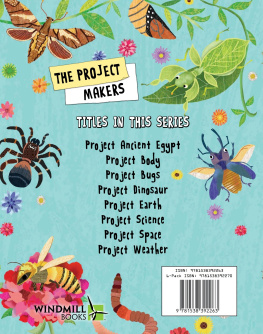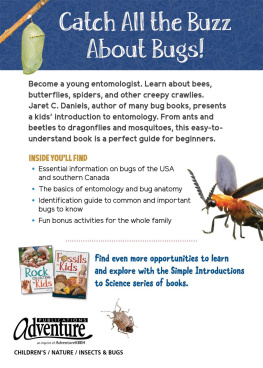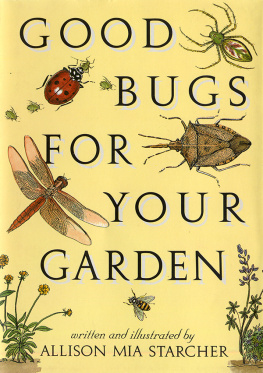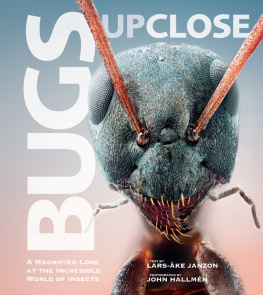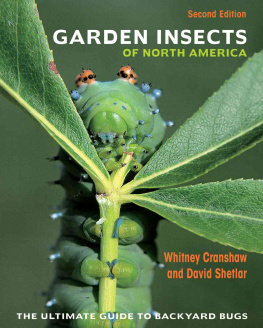
Gardens arent just for people. They are a refuge for a broad assortment of insects otherwise displaced by loss of their traditional habitat. Creating landscapes that support these creatures not only provides them with a safe haven but also can help restore ecological balance.
attracting beneficial bugs to your garden
a natural approach to pest control
Jessica Walliser
Timber Press
Portland / London
Mention of trademark, proprietary product, or vendor does not constitute a guarantee or warranty of the product by the publisher or author and does not imply its approval to the exclusion of other products or vendors.
Copyright 2014 by Jessica Walliser. All rights reserved.
Published in 2014 by Timber Press, Inc.
Photography credits appear on .
Illustrations by Colin Kinsley
The Haseltine Building | 6a Lonsdale Road |
133 S.W. Second Avenue, Suite 450 | London NW6 6RD |
Portland, Oregon 97204-3527 | timberpress.co.uk |
timberpress.com |
Book design by Breanna Goodrow
Library of Congress Cataloging-in-Publication Data
Walliser, Jessica.
Attracting beneficial bugs to your garden : a natural approach to pest control / Jessica Walliser. 1st ed.
p. cm.
Includes index.
ISBN 978-1-60469-574-8
1. Garden pestsBiological control. 2. Beneficial insects. I. Title.
SB603.5.W35 2014
628.96dc23
2013015303
contents
Introduction
How a Horticulturist Came to Bugs
All About Beneficials
Who They Are, How They Work, and What They Eat
Beneficial Bug Profiles
Meet the Predators and the Parasitoids
Gardening for Bugs
Where Plants and Insects Intersect
Plant Profiles
The Best Plants for Beneficials
Your Beneficial Border
A Guide to Designing for the Bugs
Companion Planting
Battling Pests with Plant Partnerships
Putting It All Together
Who the Beneficials Eat and What to Plant
The Commercial Stuff
Purchased Beneficials, Good Bug Lures, Supplemental Foods, and Seed Blends
introduction
how a horticulturist came to bugs

d ont be fooled by the title of this book. Yes, it is about bugsabout understanding their value to the garden and to the world. It is about encouraging the beneficial ones in hopes of mitigating the pesty ones. It is about learning to recognize how beneficial insects work, what some of them look like, and how they influence the delicate balance of the garden. But this book is also about plants. You cannot have one without the other, after all. The intent of these pages is to partner the two, to make your garden a place where bugs are welcome and a home for plants that provide for all the insects living there. It is a guide to selecting, placing, and caring for plants that encourage beneficial insects to do damage control on your behalf.

Introducing beneficial insect-friendly plants to your garden not only creates a feast for the eyes, it also creates a feast for all the creatures living there. A well-designed insectary border helps maintain a critical balance between the good and the bad bugs living in your landscape.
The objective of my words is to teach you how to design and create a landscape that fosters a diversity of plants and, as a result, a diversity of insects. This diversity does not come as a result of letting your garden go wild, nor does it mean that the insects living there will destroy your plants. To the contrary, insectary gardens are beautiful places filled with healthy, productive plants. They should be a part of every landscape, no matter where you live. Here you will find designs for creating a good bug garden of your owndesigns suited to suburban lots, city gardens, market farms, and rural backyards.
In this book you will also find interviews with entomologists from across the United States. Youll learn about fascinating research on everything from invasive exotic pests and lost ladybugs to beetle banks and farmscaping. In interviewing these entomologists, I was humbled again and again by the complexities of the workings of the insect world. I continue to have much to learn about the topic and suspect that will be the case for the rest of my life, no matter how much research I do. The scope of the insect world is both infinite and breathtaking. And so, with that in mind, I would like to make a few confessions.
CONFESSION 1 I used to spray a lot of pesticides. And I did it without any personal protection or a single thought about the possibility of any negative effects on me or the environment. At age twenty-two, working as a landscaper, I was standing one day on a 6-foot ladder spraying a clients ornamental plum tree for Japanese beetles. The wind was blowing in my face, and I could taste and smell the chemicals hitting my skin. It didnt bother me one bit. As we were driving back to the companys crew shed that afternoon, my coworker implored me to tell our boss to get me a respirator and some chemical-resistant gloves. In a surprisingly honest and emotional discussion, he told me that his wife, a fellow horticulturist, was having some health problems and her doctor had attributed them to her repeated chemical exposure. He said he didnt want it to happen to me. It got me thinking, and I had my requested respirator and gloves a week later.
CONFESSION 2 I am a former bug hater. Eventually I went on to start my own business as a professional gardener. It was my job to make sure forty different gardens looked their best, each and every day. Since my crew and I visited each garden only once per week, anytime I saw a bug, I saw the potential for a less-than-perfect garden and a disappointed client. Insects were nefarious. I carried an arsenal in the car and brought out the pump sprayer whenever I deemed it necessary. Five years after starting my business, I began to turn more to organic products at the prodding of one particular client. Then I hired someone who really set me straight. She taught me much about the dangers of chemical pesticides while we worked side by side in other peoples vegetable patches and perennial beds. I started learning and experimenting and gathering more and more information about what it really means to be an organic gardener.
CONFESSION 3 I was late in making the connection between good bugs and organic practices. I thought being organic just meant using different pesticidesones based on natural ingredients. I certainly didnt think it meant actually encouraging the presence of insects in the garden. Eventually, of course, I learned the importance of beneficial insects, and a few years later I came to the realization that it isnt just the beneficial insects that are desirable but also the pests, for without the latter the beneficial species cannot survive. I developed a true appreciation of the insect world when I wrote my third book, Good Bug Bad Bug: Whos Who, What They Do, and How to Manage Them Organically, in 2008. The book is designed as a field guide to identifying common garden pests and beneficials. What is missing from that book, however, is exactly what youll find in this one: all the tools and information you need to create a garden to protect and balance them both.
Next page



